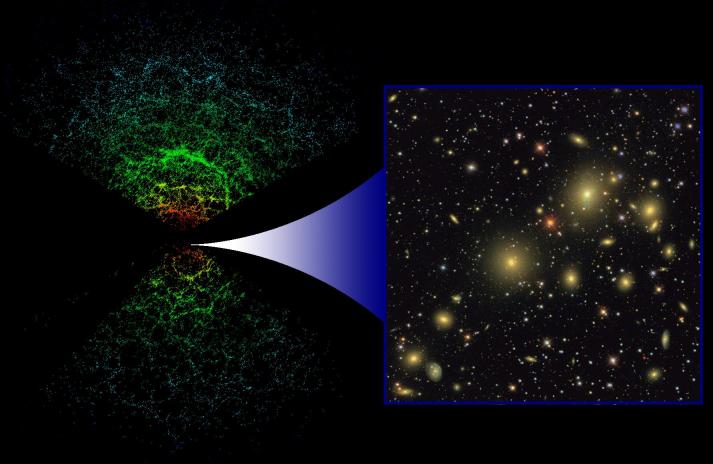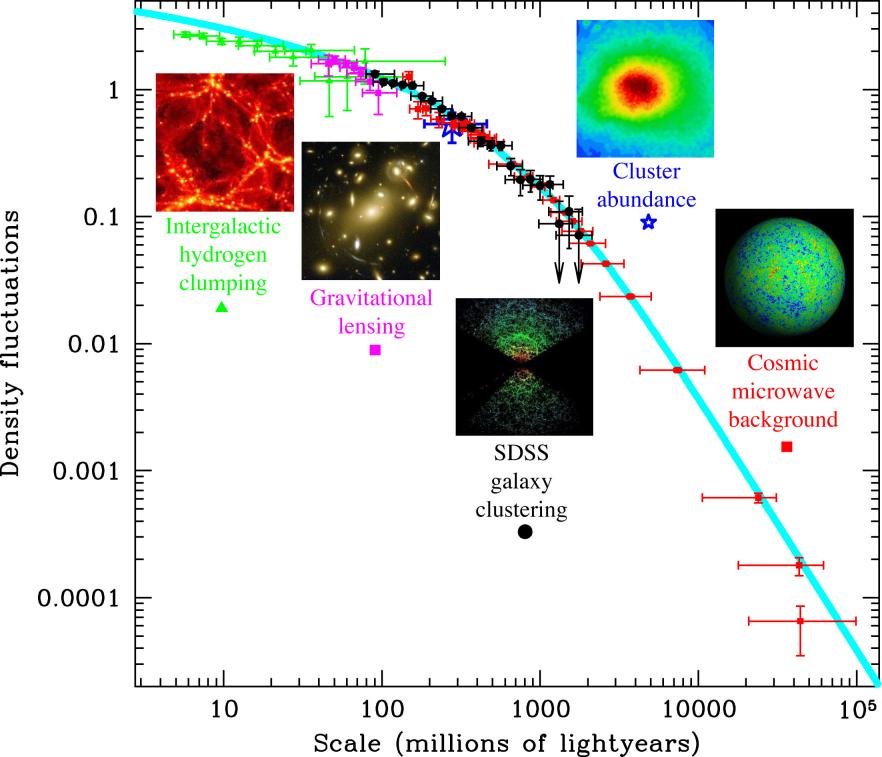
| SDSS Classic |
| SDSS.org |
| SDSS4.org |
| SDSS3.org |
| SDSS Data |
| DR19 |
| DR17 |
| DR10 |
| DR7 |
| Science |
| Press Releases |
| Education |
| Image Gallery |
| Legacy Survey |
| SEGUE |
| Supernova Survey |
| Collaboration |
| Publications |
| Contact Us |
| Search |

3D Map of Universe Bolsters Case for Dark Energy and Dark Matter
CONTACTS:Prof. Max Tegmark, Univ. of Pennsylvania, 215-898-5942, max@physics.upenn.edu
Prof. Michael Strauss, Princeton University, 609-258-3808, strauss@astro.princeton.edu
Dr. Michael Blanton, New York University, 212-992-8791, mb144@physics.nyu.edu
Gary S. Ruderman, Public Information Officer, The Sloan Digital Sky Survey: 312-320-4794 (cell), sdsspio@aol.com
October 27, 2003 -- Astronomers from the Sloan Digital Sky Survey (SDSS) have made the most precise measurement to date of the cosmic clustering of galaxies and dark matter, refining our understanding of the structure and evolution of the Universe.
"From the outset of the project in the late 80's, one of our key goals has been a precision measurement of how galaxies cluster under the influence of gravity", explained Richard Kron, SDSS's director and a professor at The University of Chicago.
SDSS Project spokesperson Michael Strauss from Princeton University and one of the lead authors on the new study elaborated that: "This clustering pattern encodes information about both invisible matter pulling on the galaxies and about the seed fluctuations that emerged from the Big Bang."
The findings are described in two papers submitted to the Astrophysical Journal and to the Physical review D; they can be found on the physics preprint Web site, www.arXiv.org, on October 28.
MAPPING FLUCTUATIONS
The leading cosmological model invokes a rapid expansion of space known as inflation that stretched microscopic quantum fluctuations in the fiery aftermath of the Big Bang to enormous scales. After inflation ended, gravity caused these seed fluctuations to grow into the galaxies and the galaxy clustering patterns observed in the SDSS.
Images of these seed fluctuations were released from the Wilkinson Microwave Anisotropy Probe (WMAP) in February, which measured the fluctuations in the relic radiation from the early Universe.
"We have made the best three-dimensional map of the Universe to date, mapping over 200,000 galaxies up to two billion light years away over six percent of the sky", said another lead author of the study, Michael Blanton from New York University. The gravitational clustering patterns in this map reveal the makeup of the Universe from its gravitational effects and, by combining their measurements with that from WMAP, the SDSS team measured the cosmic matter to consist of 70 percent dark energy, 25 percent dark matter and five percent ordinary matter.

|
The SDSS is two separate surveys in one: galaxies are identified in 2D images (right), then have their distance determined from their spectrum to create a 2 billion lightyears deep 3D map (left) where each galaxy is shown as a single point, the color representing the luminosity - this shows only those 66,976 our of 205,443 galaxies in the map that lie near the plane of Earth's equator. (Click for high resolution jpg, version without lines.) |
COSMIC CONFIRMATION
These numbers provide a powerful confirmation of those reported by the WMAP team. The inclusion of the new SDSS findings helps to improve measurement accuracy, more than halving the uncertainties from WMAP on the cosmic matter density and on the Hubble parameter (the cosmic expansion rate). Moreover, the new measurements agree well with the previous state-of-the-art results that combined WMAP with the Anglo-Australian 2dF galaxy redshift survey.
"Different galaxies, different instruments, different people and different analysis - but the results agree", says Max Tegmark from the University of Pennsylvania, first author on the two papers. "Extraordinary claims require extraordinary evidence", Tegmark says, "but we now have extraordinary evidence for dark matter and dark energy and have to take them seriously no matter how disturbing they seem."

|
The new SDSS results (black dots) are the most accurate measurements to date of how the density of the Universe fluctuates from place to place on scales of millions of lightyears. These and other cosmological measurements agree with the theoretical prediction (blue curve) for a Universe composed of 5% atoms, 25% dark matter and 70% dark energy. The larger the scales we average over, the more uniform the Universe appears. (Click for high resolution jpg, no frills version.) |
"The real challenge is now to figure what these mysterious substances actually are", said another author, David Weinberg from Ohio State University.
SDSS LARGE-SCALE UNDERTAKING
The SDSS is the most ambitious astronomical survey ever undertaken, with more than 200 astronomers at 13 institutions around the world.
"The SDSS is really two surveys in one", explained Project Scientist James Gunn of Princeton University. On the most pristine nights, the SDSS uses a wide-field CCD camera (built by Gunn and his team at Princeton University and Maki Sekiguchi of the Japan Participation Group) to take pictures of the night sky in five broad wavebands with the goal of determining the position and absolute brightness of more than 100 million celestial objects in one-quarter of the entire sky. When completed, the camera was the largest ever built for astronomical purposes, gathering data at the rate of 37 gigabytes per hour.
On nights with moonshine or mild cloud cover, the imaging camera is replaced with a pair of spectrographs (built by Alan Uomoto and his team at The Johns Hopkins University). They use optical fibers to obtain spectra (and thus redshifts) of 608 objects at a time. Unlike traditional telescopes in which nights are parceled out among many astronomers carrying out a range of scientific programs, the special-purpose 2.5m SDSS telescope at Apache Point Observatory in New Mexico is devoted solely to this survey, to operate every clear night for five years.
The first public data release from the SDSS, called DR1, contained about 15 million galaxies, with redshift distance measurements for more than 100,000 of them. All measurements used in the findings reported here would be part of the second data release, DR2, which will be made available to the astronomical community in early 2004.
Strauss said the SDSS is approaching the halfway point in its goal of measuring one million galaxy and quasar redshifts.
"The real excitement here is that disparate lines of evidence from the cosmic microwave background (CMB), large-scale structure and other cosmological observations are all giving us a consistent picture of a Universe dominated by dark energy and dark matter", said Kevork Abazajian of the Fermi National Accelerator Laboratory and the Los Alamos National Laboratory.
The authors are:
Max Tegmark, Department of Physics, University of Pennsylvania, Philadelphia, PA 19101; Dept. of Physics, Massachusetts Institute of Technology, Cambridge, MA 02139
Michael A. Strauss, Princeton University Observatory, Princeton, NJ 08544
Michael R. Blanton, Center for Cosmology and Particle Physics, Department of Physics, New York University, 4 Washington Place, New York, NY 10003
Kevork Abazajian, Theoretical Division, MS B285, Los Alamos National Laboratory, Los Alamos, New Mexico 87545
Scott Dodelson, Center for Cosmological Physics and Department of Astronomy & Astrophysics, The University of Chicago, Chicago, IL 60637;
Fermi National Accelerator Laboratory, P.O. Box 500,
Batavia, IL 605107
Havard Sandvik, University of Pennsylvania
Xiaomin Wang, University of Pennsylvania
David H. Weinberg, Department of Astronomy, Ohio State University, Columbus, OH 43210, USA
Idit Zehavi, The University of Chicago
Neta A. Bahcall, Princeton University
Fiona Hoyle, Department of Physics, Drexel University, Philadelphia, PA 19104, USA;
David Schlegel, Princeton University
Roman Scoccimarro, New York University
Michael S. Vogeley, Drexel University
Andreas Berlind, The University of Chicago
Tamas Budavari, Department of Physics and Astronomy, The Johns Hopkins University, 3701 San Martin Drive, Baltimore, MD 21218
Andrew Connolly, University of Pittsburgh, Department of Physics and Astronomy, 3941 O'Hara Street, Pittsburgh, PA 15260
Daniel J. Eisenstein, Department of Astronomy, University of Arizona, Tucson, AZ 85721
Douglas Finkbeiner, Princeton University
Joshua A. Frieman, The University of Chicago; Fermi National Accelerator Laboratory
James E. Gunn, Princeton University
Andrew J. S. Hamilton, JILA and Dept. of Astrophysical and Planetary Sciences, U. Colorado, Boulder, CO 80309
Lam Hui, Fermi National Accelerator Laboratory
Bhuvnesh Jain, University of Pennsylvania
David Johnston, The University of Chicago; Fermi National Accelerator Laboratory
Stephen Kent, Fermi National Accelerator Laboratory
Huan Lin, Fermi National Accelerator Laboratory
Reiko Nakajima, University of Pennsylvania
Robert C. Nichol, Department of Physics, 5000 Forbes Avenue, Carnegie Mellon University, Pittsburgh, PA 15213
Adrian Pope, The Johns Hopkins University
Ryan Scranton, University of Pittsburgh
Uros Seljak, Princeton University
Ravi K. Sheth, University of Pittsburgh
Albert Stebbins, Fermi National Accelerator Laboratory
Alexander S. Szalay, The Johns Hopkins University
Istvan Szapudi, Institute for Astronomy, University of Hawaii, 2680 Woodlawn Drive, Honolulu, HI 96822
Yongzhong Xu, Theoretical Division, MS B285, Los Alamos National Laboratory, Los Alamos, New Mexico 87545
James Annis, Fermi National Accelerator Laboratory
J. Brinkmann, Apache Point Observatory, 2001 Apache Point Rd, Sunspot, NM 88349-0059
Scott Burles, Massachusetts Institute of Technology
Francisco J. Castander, Institut d'Estudis Espacials de Catalunya/CSIC, Gran Capita 2-4, 08034 Barcelona, Spain
Istvan Csabai, The Johns Hopkins University
Jon Loveday, Sussex Astronomy Centre, University of Sussex, Falmer, Brighton BN1 9QJ, UK
Mamoru Doi, Inst. for Cosmic Ray Research, Univ. of Tokyo, Kashiwa 277-8582, Japan
Masataka Fukugita, University of Tokyo
Richard Gott III, Princeton University
Greg Hennessy, U.S. Naval Observatory, Flagstaff Station, Flagstaff, AZ 86002-1149
David W. Hogg, New York University
Zeljko Ivezic, Princeton University
Gillian R. Knapp, Princeton University
Don Q. Lamb, The University of Chicago
Brian C. Lee, Fermi National Accelerator Laboratory
Robert H. Lupton, Princeton University
Timothy A. McKay, Dept. of Physics, Univ. of Michigan, Ann Arbor, MI 48109-1120
Peter Kunszt, The Johns Hopkins University
Jeffrey A. Munn, U.S. Naval Observatory
Liam O'Connell, Sussex Astronomy Centre
Jeremiah P. Ostriker, Princeton University
John Peoples, Fermi National Accelerator Laboratory
Jeffrey R. Pier, U.S. Naval Observatory
Michael Richmond, Physics Dept., Rochester Inst. of Technology, 1 Lomb Memorial Dr., Rochester, NY 14623
Constance Rockosi, The University of Chicago
Donald P. Schneider, Penn State
Christopher Stoughton, Fermi National Accelerator Laboratory
Douglas L. Tucker, Fermi National Accelerator Laboratory
Daniel E. Vanden Berk, University of Pittsburgh
Brian Yanny, Fermi National Accelerator Laboratory
Donald G. York, The University of Chicago, Enrico Fermi Institute, University of Chicago, Chicago, IL 60637